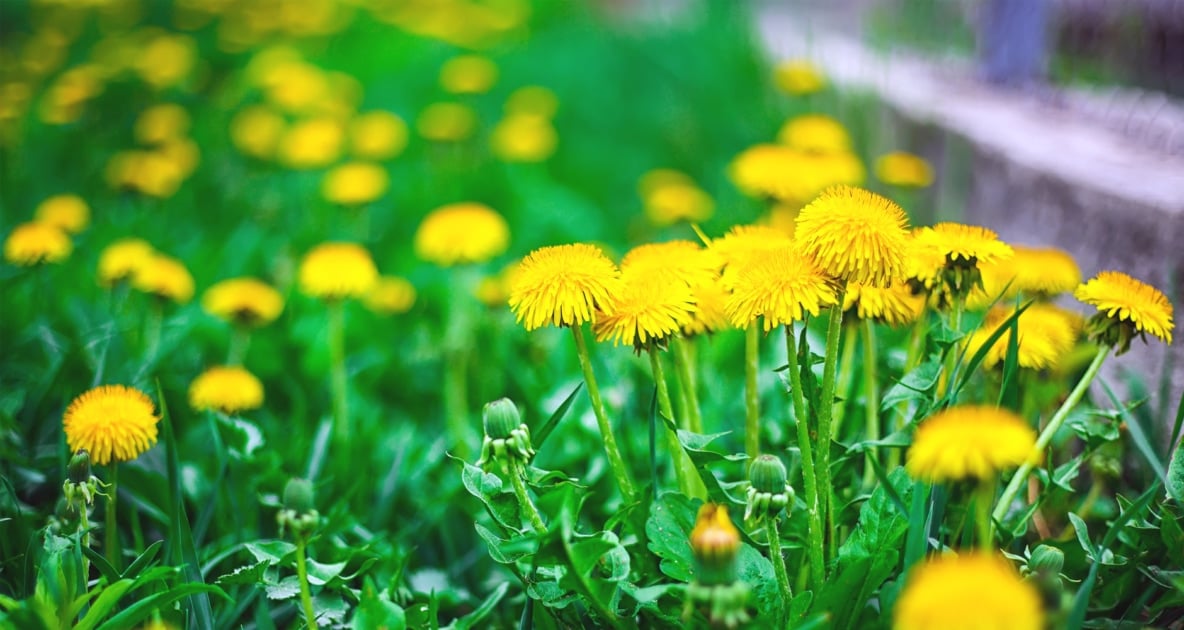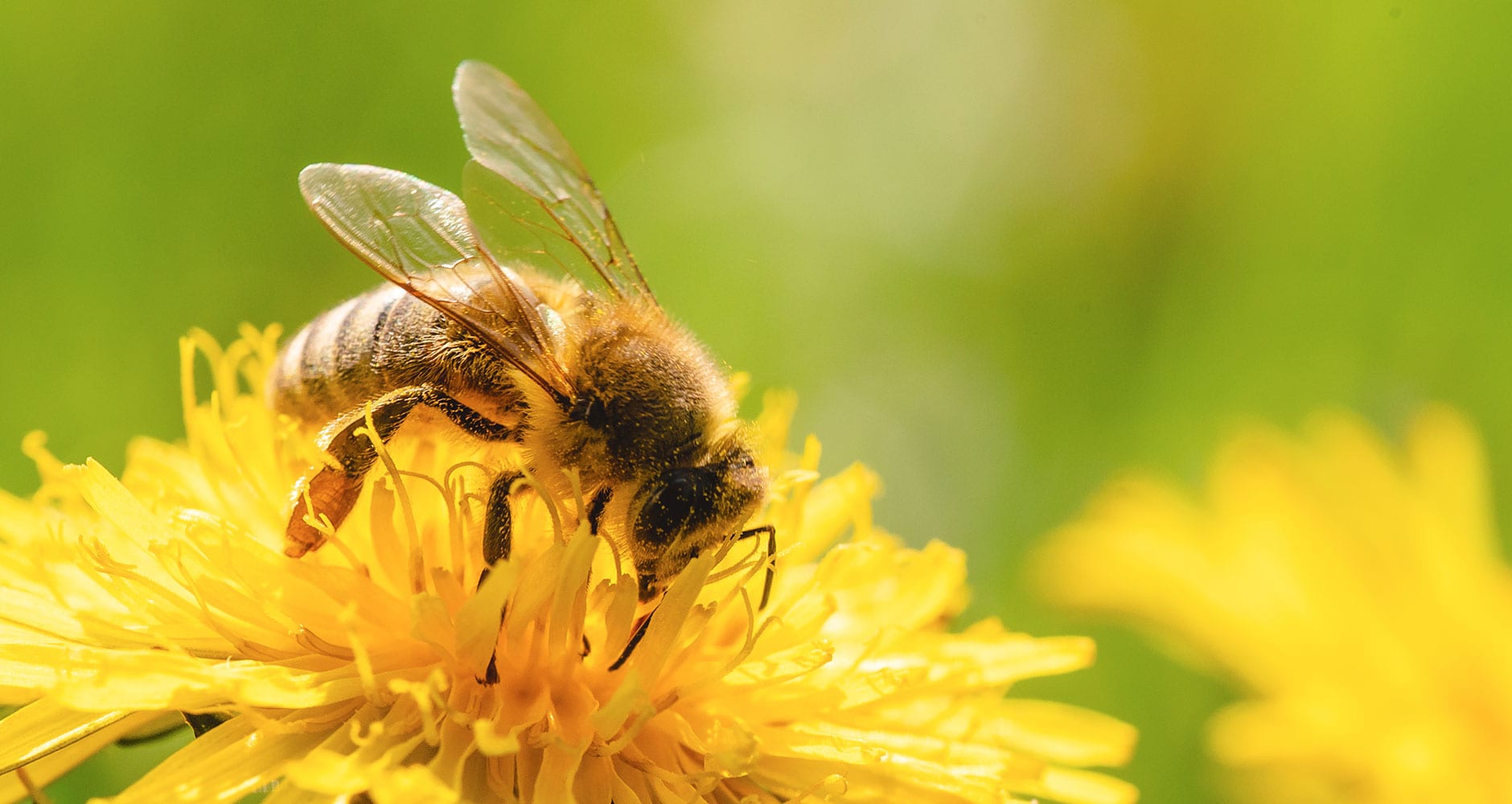Think Dandelions Are Just A Weed? Think Again!
Though commonly viewed as a weed, dandelions are beneficial in so many ways, and can be a tasty and healthful addition to your diet, helping to boost immunity and more. See the list!

When dandelions take over your yard, is your first course of action to get rid of them? It’s sort of ironic that, while we’re willing to spend time and money cultivating flowers in our gardens, these cheerful yellow flowers are widely viewed as the scourge of the suburban lawn. But it’s time to take a look at dandelions for the nutritious, beneficial plant they are.
How Did They Get Here?
Dandelions came to North America right around the same time as the first European settlers. Their name is an Anglicized version of the French phrase dent de lion, meaning “lion’s tooth,” after the plant’s broad, toothy leaves. They are now found throughout the Northern Hemisphere, in North America, Europe, and Asia.
A perennial plant, dandelions reproduce by means of the well-known parachute-like seedpods that appear in the stalk after the flower wilts. These wispy growths detach from the plant and spread on the wind.
A Friend To Bees
Though it may seem hard to believe today, dandelions were once purposely cultivated throughout North America. Their presence was deemed good for crops because they attracted bees.
Can You Eat Dandelions?
For centuries, dandelions have been valued as a natural remedy for numerous ailments, including hepatitis, kidney stones, and diabetes. They are said to promote a healthy liver and kidneys.
Dandelion greens are a rich source of vitamins and minerals, including vitamins A, C, and K, calcium, potassium, iron, and manganese. In fact, dandelion greens are a good prebiotic, meaning they may help increase the friendly bacteria in the gut which can boost the immune system.
Some research indicates that dandelion may have antimicrobial and antiviral properties, which could support your body’s ability to fight infection. Other studies found that dandelion extract significantly reduced the ability of viruses to replicate.
In addition, every part of the plant is edible. Fresh dandelion leaves have a sharp, bitter flavor that many find pleasing in salads. Just substitute them for lettuce in your favorite recipe, or mix them with other greens for a mellower flavor. Cooking them lessens their bite, and they are also popular sautéed or in soups. The flowers are often used to make a distinctive wine (recipe below).
So, before you aim that can of herbicide at your local population of dandelions, harvest them instead. Here are a few recipes to get you started:
Sautéed Dandelion Greens Recipe
Ingredients:
- 1 pound dandelion greens
- ½ cup chopped onion
- 1 clove garlic, minced
- 1 whole small dried hot chili pepper, seeds removed, crushed
- ¼ cup cooking oil
- salt and pepper to taste
- Parmesan cheese to taste
Instructions:
- Rinse dandelion greens in salted water.
- Cut leaves into two-inch pieces, and cook uncovered in a small amount of salted water, about 10 minutes or until tender.
- Sauté onion, garlic, and chili pepper in oil.
- Drain greens and add to onion and garlic mixture.
- Serve with grated Parmesan cheese, salt, and pepper to taste.
Dandelion Soup Recipe
Ingredients:
- 2 pounds dandelion greens
- 1 tablespoon olive oil
- 4 cups vegetable stock
- 2 large leeks, light parts only, sliced
- 1 carrot, diced
- 2 ½ cups milk
- 1 tablespoon Dijon mustard
- salt and pepper to taste
Instructions:
- Blanch dandelion greens in a pot of boiling salted water.
- Drain and squeeze out excess water, chop, and set aside.
- Heat olive oil in a large pot over medium-high heat.
- Add greens, carrot, and leeks and cook, stirring often, for 15 minutes.
- Add vegetable stock and simmer for about 15 minutes.
- Reduce heat to medium and whisk in milk.
- Cook, stirring frequently until slightly thickened.
- Add Dijon mustard and purée mixture in a blender until smooth.
- Season with salt and pepper to taste.
Dandelion Wine Recipe
Ingredients:
- 3 quarts dandelion blossoms
- 1 gallon water
- 2 oranges, with peel, preferably organic
- 2 lemons, with peel, preferably organic
- 3 pounds sugar
- 1 package wine yeast, available online
Instructions:
- Collect the blossoms in the morning when they are fully open. Clean thoroughly and drain. For a more delicate flavor, separate the petals from the green base.
- Bring the water to a boil and pour it over the flowers in a large pot. Cover and let steep for 24-48 hours.
- Peel the rind off lemons and oranges. Remove white pith, which will add bitterness. Slice the remaining fruit. Add the orange and lemon peels to the flower-water mixture and bring to a boil.
- Remove from heat, strain out solids, then add the sugar, stirring until it is dissolved. Allow to cool.
- Add the remaining fruit slices, yeast, and cover with cheesecloth to ferment. When the mixture has stopped bubbling (anywhere from 2 days to three weeks), fermentation is complete.
- Strain the liquid through several layers of cheesecloth and transfer to sterilized bottles.
- Cork the bottles and store in a cool, dark place for at least six months before drinking for best flavor.
Dandelion Jelly
Check out our recipe for dandelion jelly!

Jaime McLeod
Jaime McLeod is a longtime journalist who has written for a wide variety of newspapers, magazines, and websites, including MTV.com. She enjoys the outdoors, growing and eating organic food, and is interested in all aspects of natural wellness.








I found the article and recipes FASCINATING!
If you can find creasy greens ,mix them together, I like them steamed. The creasy greens offset the bitterness.
can dandelions be frozen and if so what is a good procedure
When I was a small boy and the Family was taken for a Sunday drive by our sainted father, in his 1953 Chevrolet B210 sedan, my dad would stop anywhere he spied large dandelions growing on the road side! These were used in our Sunday evening diner salad, as they are really tasty to eat!
Something new I learned today
My mom fries the flowers up like mushrooms and eats them that way.
what is wine yeast and yeast nutrient? The average person is not familiar with these terms. Are these two things available at a grocery store?
You can get these at a home brewing store. Nutrient is a booster for the yeast because the wine yeast really can’t eat regular granulated sugar very well. Wine yeast is just that a strain of yeast that eats the sugar in grape juice.
Dandelion Flower Wine Recipe – The Spruce Eats
I am nearing my eighteenth birthday, later this fall. My family has eaten dandelion greens all my life.
We simply stew them in water, as you would spinach, then eat them with a sprinkle of vinegar on top! Delicious!
Bob McIntyre
Endicott, MY
To eat fresh dandelions you must pick them in early spring while the weather is cool. Hot weather makes the dandelions bitter. Also once the flowers form they become bitter. A delicious and easy salad is oil, vinegar, salt & pepper, sliced onions and sliced hard boiled eggs. Toss all together for a delicious salad. The egg yolks tossed with the oil and vinegar dressing make a huge difference. Later when the greens begin to get bitter is when you should sauté them with garlic and oil. We only pick dandelions where no chemicals have been used.
All parts of the dandelion are so beneficial for good liver health!..From the leaves down to the roots they help as a natural detoxifier for the hard working liver.
The internet has much info on this. I drink Dandelion tea and as a side note I take Milk Thistle supplements, also. Both for the health of my liver.
I learned about these two supplements 20 yrs ago when my husband was diagnosed with Hep C which destroys the liver. Most, like my husband go undiagnosed until it’s too late. It is a silent killer.
Great info, Terri, thank you!
Do you buy the tea or make it from scratch? If from scratch, any directions for us dummys 🙂
In the early ’90s I got lab results that indicated my liver needs attention. I used dandelions and milk thistle and detoxed my liver. I was very grateful for the Drs instructions; given that was considered alternative medicine I was surprised at first.